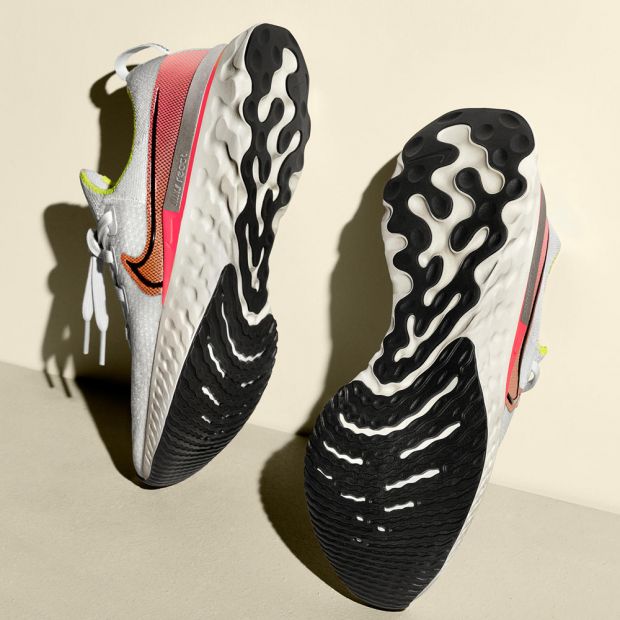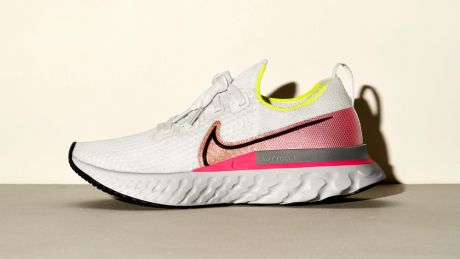You can trust Coach
If it wasn’t for the big pink swoosh on its side, you could be forgiven for mistaking the new Nike React Infinity Run for a Hoka One One shoe. It has a large stack of cushioning that’s very reminiscent of Hoka’s maximalist approach, as well as a built-in Hoka-style rocker to speed up your heel-to-toe transition.
However, this is a Nike shoe, which means it also has the company’s React foam in the midsole. Lightweight, springy and durable, the React cushioning offers a better, bouncier ride than the EVA foam in any Hoka I’ve tried yet, even if Hoka’s shoes tend to be lighter.
The combination of the React foam and the rocker makes for a very smooth and comfortable ride, and after over 100km in the shoe tackling a range of runs I’ve pegged the Infinity Run as a terrific everyday trainer and one I’m looking forward to logging a lot of kilometres in this winter.
Bret Holts, VP of Nike Running, tells Coach the Infinity Run is designed to be as versatile as the Epic React shoe for everyday training. It’s not meant to be a performance shoe like the Vaporfly, he adds, but an option for normal runners to log all their training in.
Despite the fat stack of foam on the sole it’s not too heavy (293g for a men’s size 10 and 230g for a women’s size 8), and it has enough cushioning for easy efforts while still being quick enough for faster running, even if it’s not an out-and-out speedster.
Along with a whole lot of easy running I’ve done a few faster runs in the Infinity Run, including a half marathon in around 1hr 26min and 8km at 3min 45sec/km pace followed by a few strides. The shoe has felt great throughout, and I’d only hesitate to grab it for track workouts, sessions at race pace and actual races. Even then it would be a solid marathon or half marathon race shoe for many runners – those who aren’t ready to buy a specialist racing shoe like the Nike Vaporfly or Adidas Adios 4.
I especially enjoyed using the shoe for my run commutes, which have frequently been done on cold, dark winter mornings in the rain – the kind of run you generally just want to be over, but getting to know the Infinity Run made them a lot more fun.
The Infinity Run is also designed to help reduce injuries. According to Holts, the shoe is the first step in what will be a key focus for Nike in the future.
“Our aim was to address the evergreen needs of runners of all levels,” he says. “One need is staying healthy and injury-free. This is our first step in that direction – in trying to reduce running-related injuries not just through products, but also guidance through training that we can offer though the NRC [Nike Run Club] app.
“Injury is something that has plagued runners of all levels for decades, and really the industry hasn’t made big strides in terms of reducing those rates in the past 30 or 40 years, including ourselves at Nike. We see this as an opportunity to really focus on a benefit that can help improve the running experience of all runners.”
That’s evident from the Infinity Run, which has more cushioning than past React shoes – 24% extra foam – and a wide base at the heel and forefoot to make it more stable. It’s not a stability shoe with a guidance bar to correct overpronation, though, just a more stable option for all runners to use.
- The Best Nike Running Shoes For Every Type Of Runner
- The Best Cushioned Running Shoes For Your Marathon Training
- The Best Running Shoes
- Common Running Injuries And What To Do About Them
- The Expert Guide To Strength Training For Runners

The wider forefoot does also have an extra benefit in that it means the Flyknit upper doesn’t cramp your toes at all, which has been a complaint with past Nike Flyknit shoes including the Epic React. The Infinity Run is very roomy, to the point where people with narrow feet might find it a little too spacious, but I found it only increased the comfort of the shoe.
I’d say that reducing your risk of injury is far more down to getting your training structure right than choosing the right shoe, so the guidance from the NRC app is probably the crucial bit here.
"A lot of it will come from training variation,” Holts says. “Runners do too much too soon, or they do the same run on the same route at the same pace every day, and that is what’s contributing in some cases to the injuries we see. A more holistic approach, helping runners with guidance and education, is more important than any product solution we could create.”
So if you’re just using the Infinity Run for your normal training, and ignoring the don’t-do-too-much-too-soon rule, don’t expect the shoe to save you from injury. It’s not a miracle worker.
It is, however, a terrific everyday trainer. Seriously committed runners with two or three shoes in their rotation will find the Infinity Run fits well as a cushioned option that can handle easy runs as well as tempo efforts, although you might still want something faster for speed sessions and races.
Meanwhile, I’d say the casual runner who just wants one shoe for everything will be well served by the Infinity React. I still think Nike’s Pegasus Turbo 2 is an even better all-rounder option, but it’s a little more performance-focused. The Infinity Run will be more comfortable for heavier runners and a better pick for beginners too.

Nick Harris-Fry is a journalist who has been covering health and fitness since 2015. Nick is an avid runner, covering 70-110km a week, which gives him ample opportunity to test a wide range of running shoes and running gear. He is also the chief tester for fitness trackers and running watches, treadmills and exercise bikes, and workout headphones.

